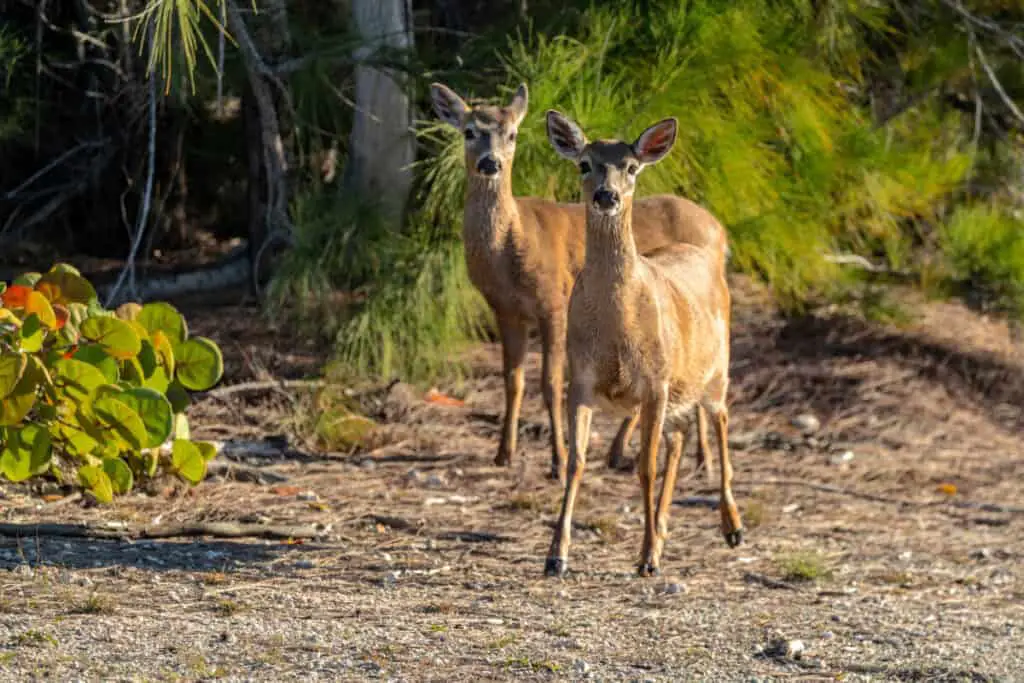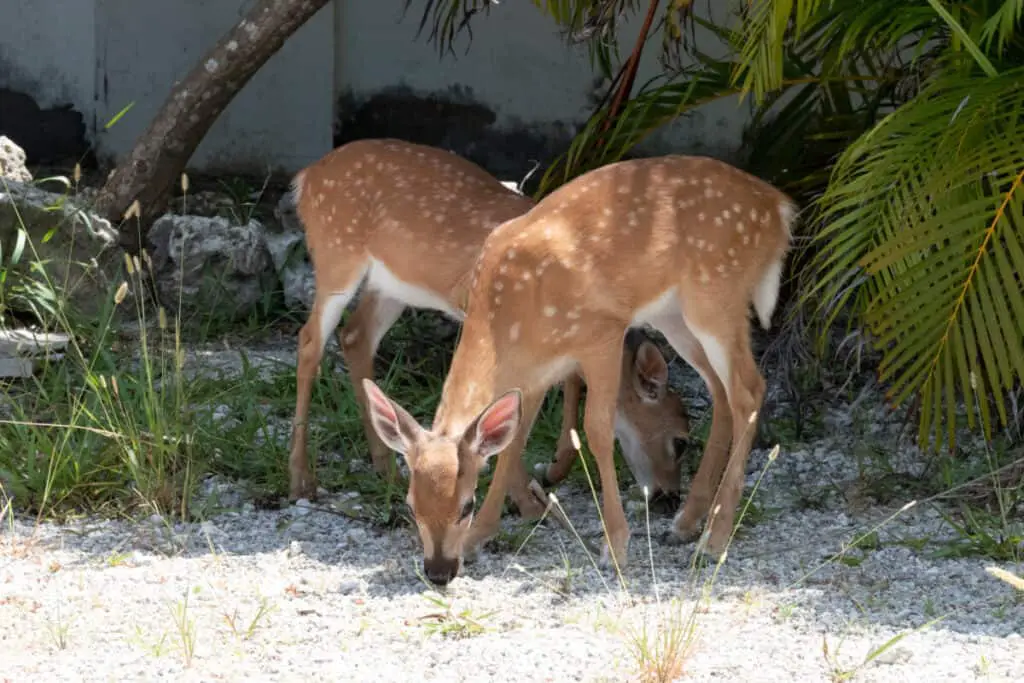The Key deer (Odocoileus virginianus clavium) is a subspecies of the white-tailed deer that inhabits the Florida Keys in the United States.
These small and endangered deer are considered to be an important part of the local ecosystem, as they play a vital role in dispersing seeds and maintaining vegetation structure.
Key deer have been facing several threats over the years, including habitat loss due to human development, predation by non-native species such as feral cats and dogs, disease outbreaks, and being hit by vehicles on roads passing through their range.
Consequently, various conservation measures have been implemented to protect these animals from extinction.
In this article, we will explore the biology of Key deer, their importance in the ecosystem, the challenges they face for survival and how conservation efforts are helping ensure their future existence.

The Biology Of The Key Deer
The Key Deer is a subspecies of white-tailed deer that is endemic to the Florida Keys. The species has evolved smaller in size compared to mainland deer, with males weighing between 55-75 pounds and females ranging from 45–65 pounds.
They have a reddish-brown coat in summer and a grayish-brown color during winter months. Habitat requirements for Key Deer include freshwater sources such as shallow ponds, marshes, and natural springs since they heavily depend on water availability.
The reproductive cycle of Key Deer starts around October when the mating season begins. Bucks compete against each other by fighting using their antlers, indicating dominance over one another.
After successful breeding occurs, does tend to give birth after seven months of gestation usually between late April through June. The fawns are born with white spots which fade away within two or three months.
Sexual maturity is attained at about eighteen months old for both sexes; however, most individuals do not reproduce until they reach two years old due to competition among bucks for territory and mates.
The Role Of Key Deer In The Ecosystem
The Biology of the Key Deer highlights the unique adaptations and behaviors that allow these small deer to survive in their native habitat. However, beyond being an interesting species to study, key deer also play a crucial role in maintaining ecosystem balance.
One important aspect of this is through their grazing habits. As herbivores, they help control vegetation growth and shape the structure of plant communities. Additionally, their browsing can create openings for other animals to access resources that may have been otherwise unavailable.
Furthermore, as prey for predators such as coyotes and panthers, key deer are part of a larger food web that supports many different species. With all these contributions, it is clear that preserving healthy populations of key deer is vital for maintaining ecosystem services and overall environmental health.
Habitat restoration efforts aimed at protecting key deer habitat should thus be prioritized so that future generations can continue to benefit from this unique species’ presence in the Florida Keys ecosystem.
Through their grazing habits and position within the food chain, key deer provide numerous benefits to the surrounding environment. These ‘ecosystem services’ contribute not only to local biodiversity but also support human well-being by providing clean air and water, soil fertility, pollination services, and more.
However, with increasing development pressures on land use practices throughout South Florida’s coastal zone impacting both terrestrial habitats (e.g., upland pine rocklands) as well as nearshore ecosystems (e.g., coral reefs), there has never been a greater need for conservation measures than now; including policies supporting sustainable agriculture/fishing practices while promoting natural resource management strategies involving various stakeholders across sectors – government agencies/NGOs/industry/private sector individuals- alike- actively engaged in ensuring continued protection/restoration efforts towards vulnerable areas like those inhabited by endangered species such as the Key Deer population which faces multiple threats today from climate change-related impacts & anthropogenic disruption alike .
This collaborative approach involves various stakeholders such as government agencies, conservation organizations, local communities, and scientific experts working together towards a common goal of conserving and restoring the natural habitats of these endangered species.
Through the implementation of effective conservation measures, such as habitat restoration, population monitoring, and public education, we can ensure the long-term survival of vulnerable species like the Key Deer.
Threats To Key Deer’s Survival
As a result of climate change and illegal hunting, Key deer populations face significant threats to their survival. The warming temperatures have led to habitat loss, changes in vegetation patterns, and increased frequency and severity of natural disasters such as hurricanes. All these factors have contributed to the decline in the available food sources for key deer, exacerbating their vulnerability.
Illegal hunting is another major threat to the existence of Key deer populations. Despite strict regulations on hunting activities, poachers continue to hunt Key deer illegally. This activity poses an immediate danger to key deer since it reduces their population size directly. Furthermore, hunters often target larger males with antlers which leads to skewed sex ratios within populations that can lead ultimately impact breeding success rates.
- Rising sea levels are leading to saltwater intrusion into freshwater habitats.
- Warmer temperatures contribute negatively towards key deer’s migration habits.
- Increase in urbanization has resulted in habitat fragmentation.
- Invasive species such as Burmese pythons prey upon juvenile key deers.
- Habitat loss results from human encroachment into protected areas, leading to a reduction in available resources and space for the key deer population.
Human Development And Habitat Loss
The impact of urbanization on key deer populations has been significant, as it has caused habitat loss and fragmentation.
Urbanization refers to the growth and expansion of cities, which leads to an increase in population density and the establishment of new buildings and infrastructure. This process often involves deforestation for the construction of roads, housing developments, commercial areas, and agricultural fields.
Deforestation effects include changes in temperature and humidity levels that can negatively affect plant communities while enabling invasive species to thrive. Deforested areas have a reduced capacity for carbon sequestration, leading to increased greenhouse gas emissions.
The loss of natural habitats also impacts wildlife populations by reducing their food sources or displacing them entirely from their home ranges. In addition, fragmented landscapes create barriers to movement between habitats, affecting migration patterns and genetic diversity among animal populations.
Overall, human development activities such as urbanization and deforestation continue to pose severe threats to key deer populations over time. However, conservation efforts aimed at preserving remaining habitat patches can play a critical role in mitigating these negative effects through restoration projects and land-use planning strategies that prioritize biodiversity conservation goals alongside economic interests.

Predation And Disease Outbreaks
As human development and habitat loss continue to threaten the existence of various species, one such example is the key deer. This small subspecies of white-tailed deer found only in the Florida Keys faces numerous challenges for survival.
The population has decreased drastically due to increased urbanization, road construction, and loss of natural habitat. To survive these threats, key deer have developed several strategies including adapting their feeding habits, utilizing available resources more efficiently, and altering their behavior patterns during times of high human activity.
However, despite these efforts, they remain vulnerable to predation and disease outbreaks which can significantly impact their population dynamics. In order to sustain this unique subspecies’s existence, it is crucial that conservation efforts are put into place to protect their habitats from further destruction and prevent future harm caused by external factors.
Tragic consequences of human actions on wildlife
Importance of taking action towards preserving endangered species
Urgency in protecting our planet’s biodiversity
Conservation Efforts To Save Key Deer
Like a tiny speck amidst the vast wilderness, the Key Deer population has been dwindling at an alarming rate. However, this precious species is not alone in its fight for survival, as conservation efforts have been initiated to save it from extinction.
One of the significant contributors to these initiatives is community involvement. The local residents have come forward to support and participate in various programs that are aimed towards protecting these deer from human-induced threats such as habitat loss due to urbanisation.
Apart from community participation, government initiatives have also played a crucial role in preserving the Key Deer population. In 1957, President Dwight D. Eisenhower established the National Key Deer Refuge on Big Pine Key, which covers over 9,000 acres of land dedicated solely to conserving this endangered species. Later on, several other acts were put into place by different governmental organisations that highlighted the significance of protecting wildlife habitats and ensuring their sustainable development.
Through collective efforts by both communities and governments alike, there has been a noticeable increase in the number of Key Deer sightings in recent years. These steps show us that when we work together towards a common goal, even something as small as saving one particular species can make all the difference.
Conclusion
The Key Deer is a unique and precious species that plays an important role in the fragile ecosystem of Florida.
Despite their small size, they have significant ecological importance as pollinators and seed dispersers.
However, human development and habitat loss pose a serious threat to their survival, along with predation and disease outbreaks.
Ironically, it is often humans who are responsible for both endangering and saving this vulnerable species.
Through conservation efforts such as protecting habitats, controlling predators, and monitoring diseases, we can ensure the continued existence of these beloved creatures.
The fate of the Key Deer rests in our hands – will we choose to prioritize their preservation or succumb to short-sighted development?
Only time will tell if we can learn from our past mistakes and secure a brighter future for all living beings on Earth.

